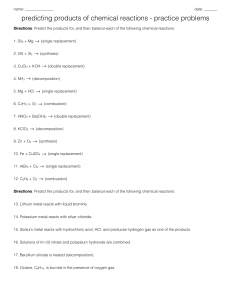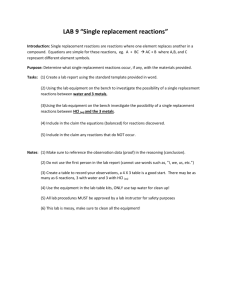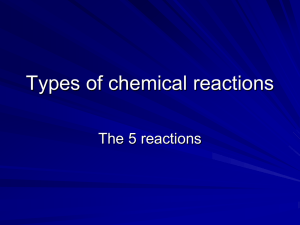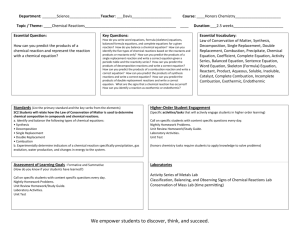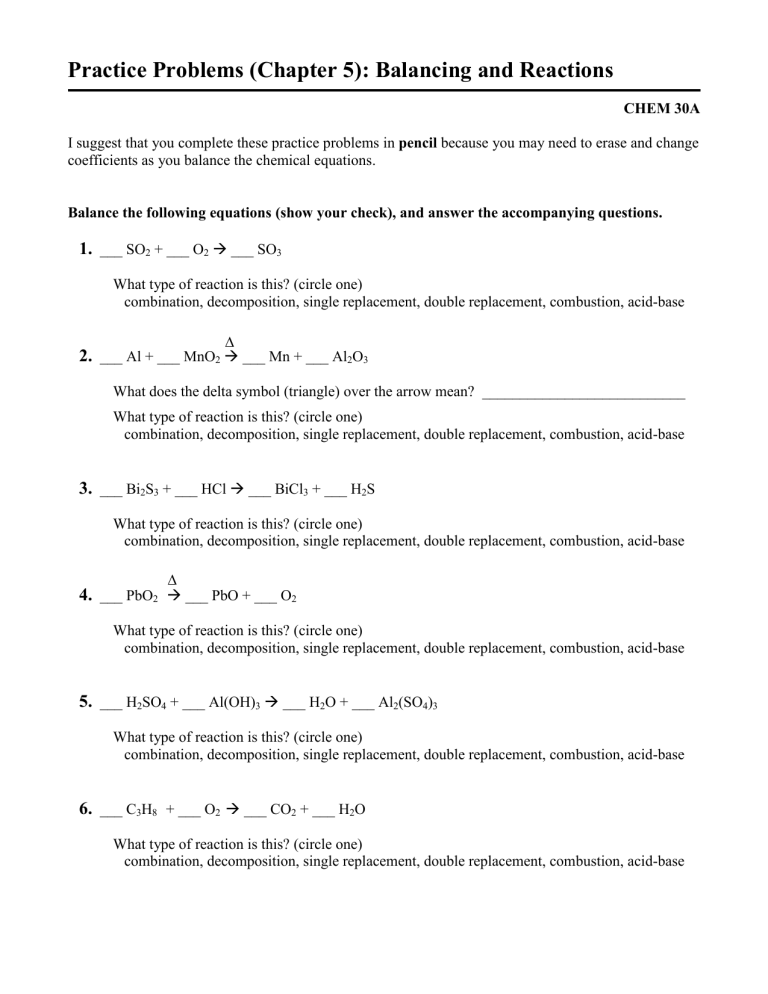
Practice Problems (Chapter 5): Balancing and Reactions CHEM 30A I suggest that you complete these practice problems in pencil because you may need to erase and change coefficients as you balance the chemical equations. Balance the following equations (show your check), and answer the accompanying questions. 1. ___ SO2 + ___ O2 ___ SO3 What type of reaction is this? (circle one) combination, decomposition, single replacement, double replacement, combustion, acid-base 2. ___ Al + ___ MnO2 ___ Mn + ___ Al2O3 What does the delta symbol (triangle) over the arrow mean? ___________________________ What type of reaction is this? (circle one) combination, decomposition, single replacement, double replacement, combustion, acid-base 3. ___ Bi2S3 + ___ HCl ___ BiCl3 + ___ H2S What type of reaction is this? (circle one) combination, decomposition, single replacement, double replacement, combustion, acid-base 4. ___ PbO2 ___ PbO + ___ O2 What type of reaction is this? (circle one) combination, decomposition, single replacement, double replacement, combustion, acid-base 5. ___ H2SO4 + ___ Al(OH)3 ___ H2O + ___ Al2(SO4)3 What type of reaction is this? (circle one) combination, decomposition, single replacement, double replacement, combustion, acid-base 6. ___ C3H8 + ___ O2 ___ CO2 + ___ H2O What type of reaction is this? (circle one) combination, decomposition, single replacement, double replacement, combustion, acid-base Write formula equations from the following word equations, then balance them (show your check). 7. phosphoric acid + calcium hydroxide calcium phosphate + water ___ __________ + ___ __________ ___ __________ + ___ __________ 8. zinc carbonate + hydrochloric acid zinc chloride + water + carbon dioxide ___ __________ + ___ __________ ___ __________ + ___ __________ + ___ __________ 9. silver nitrate + aluminum chloride silver chloride + aluminum nitrate ___ __________ + ___ __________ ___ __________ + ___ __________ 10. silver oxide silver + oxygen ___ __________ ___ __________ + ___ __________ Predict the products for the following combination reactions and balance them (show your check). The product of each reaction is a charge neutral ionic compound. 11. ___ Mg(s) + ___ O2(g) 12. ___ Al(s) + ___ Br2(l) 13. ___ Cu(s) + ___ FeCl3(aq) 14. ___ Al(s) + ___ HBr(aq) 15. ___ H2(g) + ___ Al2O3(aq) 16. ___ Cl2(g) + ___ HBr(aq) 17. ___ I2(s) + ___ HCl(aq) Activity Series: Metals (and Hydrogen) form cations K Ca Na Mg Al Zn Fe Ni Sn Pb H Cu Ag Hg Au Non-Metals (Halogens) form anions F2 Cl2 Br2 I2 increasing activity Predict the products for the following single replacement reactions and balance them (show your check). If no reaction occurs, write “no reaction” on the product side of the arrow. Predict the products for the following double replacement reactions and balance them (show your check). Use the solubility rules to determine if a precipitate (solid) will form. Label the phase of insoluble products as solid and soluble products as aqueous. 18. ___ Cu(NO3)2(aq) + ___ FeCl3(aq) 19. ___ Ba(C2H3O2)2(aq) + ___ (NH4)2SO4(aq) 20. ___ KCl(aq) + ___ Pb(NO3)2(aq) 21. ___ Na2CO3(aq) + ___ CaBr2(aq) 22. ___ CaCl2(aq) + ___ AgNO3(aq) Complete the following combustion reactions (in air) and balance them (show your check). 23. ___ C2H2(g) + ___ ______(g) 24. ___ C3H8(g) + ___ ______(g) 25. ___ C2H5OH(l) + ___ ______(g) 26. ___ CH4(g) + ___ ______(g) Predict the products for the following acid-base neutralization reactions and balance them (show your check). 27. ___ HBr(aq) + ___ Al(OH)3(s) 28. ___ HCl(aq) + ___ CaCO3(s) 29. ___ H2SO4(aq) + ___ KOH(aq) 30. ___ H3PO4(aq) + ___ Ba(OH)2(aq)
